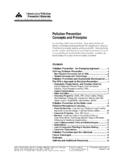Transcription of E-Waste Recycling In India – Bridging The Gap …
1 E- waste Recycling In India Bridging The Gap Between The Informal And Formal Sector Dr. Lakshmi Raghupathy, MAIT-GTZ Mrs Christine Kr ger, adelphi Dr. Ashish Chaturvedi, GTZ-ASEM Dr. Rachna Arora, GTZ-ASEM Mr Mikael P. Henzler, adelphi CONTACT Christine Kr ger adelphi Caspar-Theyss-Strasse 14a T +49 30 89 000 68-36 F +40 30 89 000 68-10 EXECUTIVE SUMMARY In this paper the authors will present options for Bridging the gap between the formal and informal divide in E-Waste management in India . These options are being developed, implemented and evaluated in the framework of different Indian, European, and bilaterally financed studies and projects focusing on Delhi, Bangalore, Pune and Kolkata. Electrical and electronic waste ( E-Waste ) is one of the fastest growing waste streams in the world.
2 According to a recent study carried out by MAIT and GTZ in 2007 about 380,000 tons of E-Waste are generated annually in India and the generation of E-Waste is expected to touch 470,000 tons by 2011. The study also reveals that only about 6 percent of the E-Waste is recycled, of which 95 percent is recycled through the informal sector. E-Waste Recycling in the informal sector provides jobs to thousands of people and supports the formal waste management agencies like municipalities. Investigations of the authors showed that the existence of an informal but entrepreneurial SME based infrastructure permits a profitable E-Waste management business. At the same time, the informal sector is lacking skills and technologies, and manages hazardous material without any regard to occupational health and safety (OH&S) requirements and in an environmental harmful manner.
3 It is observed that with rising E-Waste quantities the Recycling scenario is changing, with the formal recyclers increasingly entering the E-Waste Recycling sector. There is a widespread expectation that these formal sector recyclers would be able to manage E-Waste in an environmentally sound manner by using Best Available Technologies (BAT) leading to better environment management and enhanced resource recovery. However, it is not clear whether the advent of formal Recycling would come at the expense of informal sector recyclers or would complement their activities. In this paper, we present a model which allows the integration of the informal and the formal sectors in India . The broad building blocks of this model are a) federating disparate informal sector workers into collectives; b) capacity building at various stages of the E-Waste value chain; c) development of appropriate framework conditions in support of the informal sector; d) elaboration of applicable business structures taking into account the constraints and resources of the informal and formal sectors, and e) implementation, monitoring and evaluation of the model in different baseline situations.
4 We show that there are mutual gains to be obtained from an increased cooperation between the formal and informal sector because of their competitive advantages. Social welfare is enhanced through this interaction. It furthermore leads to reduced pollution, better resource management and creation of green jobs in the Recycling sector. The outcomes of the investigation suggest that the collection, segregation and primary dismantling of non-hazardous fractions of E-Waste should be focused in the informal sector while the other higher order Recycling processes may be concentrated in the formal sector. We further illustrate elements of the model with several initiatives implemented in India . INTRODUCTION The increased use of electrical and electronic equipments and the high rate of obsolescence of this equipment leads to an increased generation of E-Waste .
5 The alarming rate of electrical and electronic waste ( E-Waste ) generation has become a major global concern and E-Waste Recycling is now an important economic activity. It is a well known fact that E-Waste also contains hazardous constituents that are potentially harmful to the environment and human health if they are not handled properly. The presence of valuable resources such as copper, silver, gold and platinum make it attractive to recycle E-Waste . Recycling activities have invariably been associated with small backyard operators involving a large work force and located mostly in the developing nations. The major activity in E-Waste Recycling is dismantling which is labour intensive and requires manual operations which are available in abundance in poor nations.
6 In India a number of studies have been carried out since 2004 on E-Waste generation and its Recycling in different geographical locations. According to recent studies carried out by Manufacturer s Association of Information Technology (MAIT) and the Gesellschaft f r Technische Zusammenarbeit (GTZ) in 2007 about 380,000 tons of E-Waste are generated annually in India and taking into account the sales of PC and consumer electronics the generation of E-Waste is expected to touch 470,000 tons by 2011. The study also reveals that only about 19,000 tons of E-Waste are recycled and large amounts of E-Waste are refurbished and sold in the secondary market. With rising quantities, awareness and interest from policy makers regarding the issue, the Recycling scenario is changing with the formal recyclers entering the E-Waste Recycling sector.
7 There is widespread expectation that these formal sector recyclers would be able to manage E-Waste in an environmentally sound manner by using Best Available Technologies (BAT) leading to better environment management and enhanced resource recovery. However, it is still not clear whether the advent of formal Recycling would come at the expense of informal sector recycler or would complement their activities. In this paper, we present a model, which allows the integration of the informal and the formal sectors in India . The broad building blocks include a) federating the informal sector workers into collectives; b) capacity building at various stages of the E-Waste value chain; c) development of appropriate framework conditions in support of the informal sector; d) elaboration of applicable business structures taking into account the constraints and resources of the informal and formal sectors, and e) implementation, monitoring and evaluation of the model in different baseline situations.
8 The expected mutual gains from an increased cooperation between the formal and informal sector is brought out. The other benefits highlighted include social welfare, reduced pollution, better resource management and creation of green jobs in the Recycling sector. These options have been developed, implemented and evaluated in the framework of different India -European Union (EC) bilaterally financed studies and projects focusing on Delhi, Bangalore, Pune and Kolkata. E-Waste SCENARIO IN India The electronics industry has emerged as the fastest growing segment of Indian industry both in terms of production and exports. The share of software services in the electronics and IT sector has gone up from percent in 1998-99 to percent in 2003-04.
9 The liberalization, and the opening up of Indian markets together with the change in India s import policies vis- -vis hardware leading to substitution of domestically produced hardware by imports has facilitated an IT penetration in the Indian market at an accelerated pace. The IT industry is the prime mover with an annual growth rate of percent between 1995 and 2000. By the end of financial year 2005-06, India had an installed base of 4,640,000 desktops, about 431,000 notebooks and 89,000 servers. According to the estimates made by MAIT the Indian PC industry is growing at 25 percent annually. During 2007-08 ICT PC sales grew at 16 percent annually and consumer electronics sales grew at 13-15 percent annually while the cellular phone subscribers reached a growth rate of percent in 2008.
10 With the increased use of electrical and electronic equipments the E-Waste generation also increased but the assessment shows that only about percent of this E-Waste is being recycled. The fate of the rest of the waste is still unknown. According to the assessments made, 60-70 percent of the total E-Waste generated is from ten states and sixty-five cities in India . Maharashtra ranks first followed by Tamil Nadu, Andhra Pradesh, Uttar Pradesh, West Bengal, Delhi, Karnataka, Gujarat, Madhya Pradesh and Punjab in the list of E-Waste generating states in India . Among the top ten cities generating E-Waste , Mumbai ranks first followed by Delhi, Bangalore, Chennai, Kolkata, Ahmedabad, Hyderabad, Pune, Surat and Nagpur.







